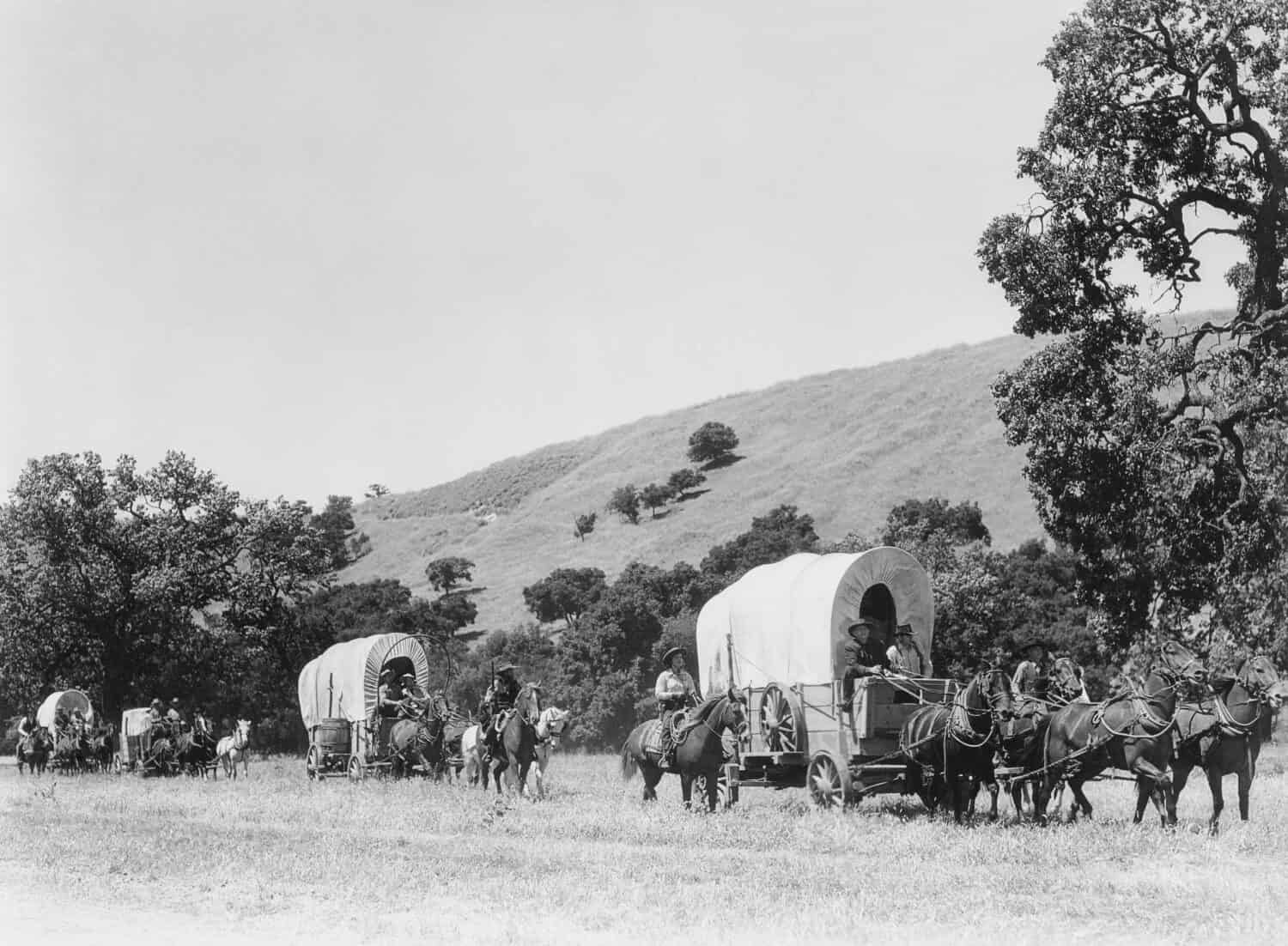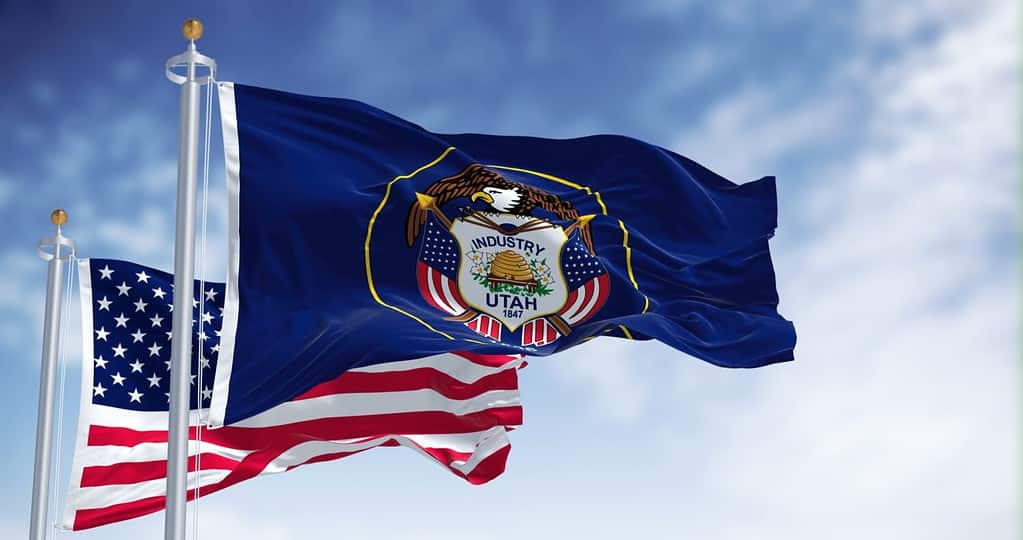On one hand, a flag is just a simple piece of cloth. On the other hand, however, a flag can be a powerful and binding force that unites people under a common identity. The official state flag of Utah represents the history and culture of the state. It also reminds its people of the beauty of their natural surroundings and what it is that makes Utah so special. Let’s dive in and take a closer look at Utah’s state flag, learn more about its history, meaning, and symbolism — and see how this simple piece of cloth represents the Beehive State!
Where is Utah?

Utah shares a border with Colorado, Wyoming, Nevada, Idaho, and Arizona.
©Alexander Lukatskiy/Shutterstock.com
Utah is at the heart of the western United States, tucked neatly between the Rocky Mountains and the Great Basin. It is one of the four states that create the famous “Four Corners”, along with Colorado, Arizona, and New Mexico. To the east, Utah shares a border with Colorado and Wyoming. To the West, it shares a border with Nevada and Idaho.
Utah’s Natural Wildlife

Utah includes majestic wildlife, such as the Rocky Mountain elk, a Utah state animal.
©iStock.com/MattCuda
Utah is a state of dramatic contrasts and breathtaking beauty like the towering peaks of the Wasatch Mountains, the sweeping desert landscapes, and the otherworldly rock formations of Bryce Canyon National Park and Zion National Park. The unique habitats in Utah also support an incredible diversity of wildlife. There are impressive elk herds in its mountains and swift pronghorns sprinting across its desert plains. Utah is also home to majestic bison, elusive cougars, and playful river otters. You can also see many different species of birds in the state, like peregrine falcons, bald eagles, and great blue herons.
The History and Origin of the Flag of Utah

Utah has a history of Mormon pioneers.
©Everett Collection/Shutterstock.com
Utah was originally inhabited by many different Native American groups, from the ancient Puebloans to the Ute and Navajo tribes. Spanish explorers came to Utah in the 1500s but decided that the area was too difficult to live in due to its harsh weather and challenging landscape. Eventually, it became a Mexican territory, but many settlers from the United States still moved into the area. The majority of people flocking to Utah at that time were Mormons who were fleeing persecution and violence.
These Mormon pioneers embarked on a treacherous journey across thousands of miles of uncharted territories in search of an isolated region where they could build a new home. Many died before reaching Utah due to extreme weather conditions and disease. What others believed was nothing but a desolate valley in Utah, the pioneers saw as a sanctuary and safe haven after their grueling journey across the plains.
By the end of 1847, nearly 2,000 Mormon pioneers had settled in Utah’s Salt Lake Valley. They created the first flag in Utah the following year to celebrate their first “Pioneer Day” on July 24, 1848. This first flag was lost, but records show that it had a similar structure to the American flag. However, the flag had blue and white stripes instead of red and white stripes. There are also 12 smaller stars encircling a larger star in the top left-hand corner. In 2002 the Church of Jesus Christ of Latter-day Saints recreated this flag. It now flies at Ensign Peak near Salt Lake City.
Utah’s First Official Flag
Utah officially became a state on January 4, 1896, but a new flag wasn’t adopted until 1911. This flag was actually created years before, in 1903, by the Daughters of the American Revolution in Utah. It was blue and had the official State Seal of Utah in the center, all in white. The date “1847” (the year the pioneers entered the valley) was displayed prominently in the middle of the seal. “1896” was stitched below the shield to commemorate the year that Utah became a state. Governor Heber M. Wells used it in the parade of states at the Louisiana Purchase Exposition in St. Louis, Missouri. However, it was not until March 9, 1911, that the Utah State Legislature officially adopted this flag — even though it had already been flown and used at all state functions from 1904 to 1911.
The 1913 Design of the Utah Flag
The Sons and Daughters of the Utah Pioneers ordered new flags for the USS Utah Battleship in 1912. They had ordered flags with the original white-on-blue design. However, they instead received new flags printed in full color with an additional gold ring encircling the state seal. Instead of repurposing the flag, Utah representative Annie Wells Cannon proposed that the legislature officially adopt these new changes — and they did! They flew the new flag in January 1913 at the Utah State Capitol.
An 80-Year-Old Mistake
The 1913 Utah flag design did not change for several more decades. However, in 1922 a flag maker accidentally stitched the year “1847” just above the year “1896” instead of placing it on the shield. The mistake went unnoticed, and flag makers continued to use this 1922 flag as a model. They ended up keeping the misplaced dates on all Utah flags made for the next 89 years! It was not until 2011 that the Utah State Legislature adopted a new resolution requiring the mistake to be fixed. During the same session, the legislature also passed a bill declaring Utah’s State Flag Day as March 9.
The Meaning and Symbolism of Utah’s Historic Flag

The official Utah state flag features a honeybee hive.
©rarrarorro/Shutterstock.com
The Utah state flag has flown proudly for over 100 years and contains many powerful symbols that represent the history of the state. The flag is dark blue, with the Utah State Seal in the middle. The seal features a large bald eagle with its wings spread wide above a shield. Utah’s state motto, “INDUSTRY,” is embroidered at the top of it. At the center of the shield sits a beehive with sego lilies (Calochortus nuttallii) growing on either side and the year “1847” is etched below. An American flag stands on either side of the shield with the year “1896”.
Utah is often known as the “Beehive State”. The beehive at the center of the shield represents this as well as the state motto of “industry”. The sego lilies on each side of the beehive represent Utah’s official state flower. These flowers only grow in the desert environments of the western United States. “1847” is the year that the Mormon pioneers settled in Utah, and “1896” is the year that Utah officially joined the Union as the 45th state. The two American flags on the Utah state flag are a unique addition — very few states incorporate the American flag as part of their state flag. However, Utahans wanted to proudly display their loyalty to the United States, as it had been questioned earlier due to religious conflicts.
A New Utah Flag for the 21st Century
Beginning in 2018, representatives in Utah began a discussion about changing Utah’s official state flag, keeping the old flag as Utah’s official historical flag. The public submitted 5,703 designs (2,500 from students) in 2022. The Utah State Flag Task Force chose 20 semi-finalist designs, and for one month, Utahans could vote and give feedback on the designs. The Task Force then combined elements from two of the top designs to create the final one. They proposed this final design to the Utah State Legislature on November 10th, 2022.
Although the legislature approved the design, it was slightly altered after receiving more public feedback. Some of the Native American citizens of the state felt that the eight-pointed star looked too much like an asterisk, which, unfortunately, is how they have been treated far too often in U.S. History. They didn’t want to also feel like an asterisk on their state flag.
The Utah House of Representatives and the Utah State Senate approved the design and bill. Then Governor Cox signed the bill on March 21st, 2023, and declared that Utah will officially adopt the new flag on March 9th, 2024. The new and historic state flags will be flown from their own separate flagpoles at the Utah State Capitol.
The Meaning and Symbolism of Utah’s New State Flag
Utah’s new state flag is unique because the public created it. Its design elements come from the people of Utah, and the Task Force tried to include everyone’s opinion in its creation. The goal was to have a flag that not only represented the people but was also made by the people.
The background of Utah’s new state flag is blue, which is reminiscent of Utah’s historic flag. Blue also stands as a symbol for Utah’s exquisite, wide-open skies and the state’s beautiful lakes. In addition, the color blue also stands for freedom, knowledge, tradition, and optimism.
A yellow beehive sits in the middle of the new Utah State flag, once again alluding to Utah’s history as well as the state’s motto of “industry”. The white five-pointed star just below the beehive sits to represent the important foundation of Native Americans in Utah. Surrounding these symbols is a gold hexagon, a shape that symbolizes unity and strength.
A large white segment with jagged edges runs across the length of the flag, representing peace and the many majestic mountains in Utah. A thick red section at the bottom of the flag also symbolizes southern Utah’s iconic canyons and national parks.
Utah’s State Symbols

Utah’s official state flag includes a honeybee, which is also one of the official state symbols.
©Aleksandr Rybalko/Shutterstock.com
In addition to Utah’s official state flag and historic flag, the state also recognizes many other official symbols that represent its people, landscape, and culture. Known as the “Beehive State,” Utah’s official state emblem is the beehive, symbolizing the state’s ” industry ” motto. Moreover, the official state insect is the honey bee, the official state astronomical symbol is the Beehive Cluster, and the official state stone is honeycomb calcite!
However, there are also state symbols that do not involve honeybees and beehives. Here are a few more examples of Utah’s official state symbols:
- Utah’s official state motto: “Industry”
- Utah’s official state insect: Honey bee (Apis mellifera)
- Utah’s official state emblem: Beehive
- Utah’s official state astronomical symbol: The Beehive Cluster
- Utah’s official state stone: Honeycomb calcite
- Utah’s official state flower: Sego lily (Calochortus nuttallii)
- Utah’s official state animal: Rocky Mountain elk (Cervus canadensis nelsoni)
- Utah’s official state fish: Bonneville Cutthroat trout (Oncorhynchus clarki Utah)
- Utah’s official state reptile: Gila monster (Heloderma suspectum)
- Utah’s official state bird: California gull (Larus californicus)
- Utah’s official state tree: Quaking aspen (Populus tremuloides)
- Utah’s official state fossil: Allosaurus
The photo featured at the top of this post is © rarrarorro/Shutterstock.com
Thank you for reading! Have some feedback for us? Contact the AZ Animals editorial team.







